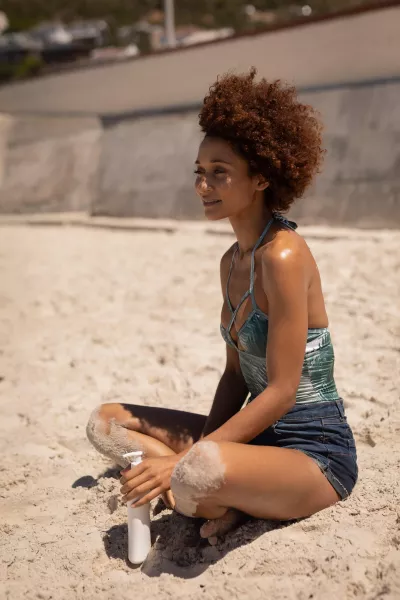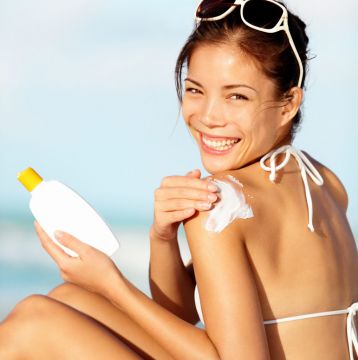With the spell of good weather expected to last until next week, time to make sure you're stocked up on sunscreen.
We all know sunburn is not just painful, but bad for our skin, and that a generous slathering of cream is essential to prevent the risk of developing skin cancer.
But when it comes down to the nitty-gritty, how much do you really know about sunscreen? Can you, for example, still use the bottles you bought last year? Do kids need more protection than adults? And what about those newfangled facial mists – are they really strong enough to ward off harmful rays?
We asked skincare experts to fill us in on seven common SPF queries.
1. Does sunscreen go off?

“Yes, and using an SPF that’s past its shelf life means it won’t protect effectively,” says Abi Cleeve, MD at Ultrasun and founder of SkinSense. “Always check the small symbol on the bottle, a pot with the number of months it is effective after opening.”
She adds: “All Ultrasun products have a shelf life of two years after opening, against an average for most sun creams of six to 12 months, due to the specific lamellar formula used.”
2. Should children always wear factor 50?

Laura Harker, lead screening nurse at The Mole Clinic, says: “Babies and younger children need extra care, and children aged under six months should be kept out of direct strong sunlight. This is because their skin is much more sensitive than adult skin, and damage caused by repeated exposure to sunlight could lead to skin cancer developing in later life.”
She recommends parents use at least SPF 30 on their kids, depending on “age and strength of the sun. Ideally, in the summertime, children should cover up with suitable clothing and spend time in the shade, particularly from 11am to 3pm, when the sun is strongest”.
3. Why does sunscreen sometimes give you spots?
“This can often be because of the formula,” says Cleeve. “Physical formulas sit on the surface of the skin which can cause irritation, or the presence of fragrance and emulsifiers can cause sensitive skins to react.”
Check the ingredients list if you want to avoid these acne-causing irritants and look for sunscreen that’s non-comedogenic, meaning it won’t block pores.
“Spots can be due to not removing sunscreen properly,” says Chelsey Edmunds, campaigns and communications manager at Escentual. “Use an oil-based cleanser to remove, as the filters can clog pores.”
4. Do SPF mists really give your face enough protection?
“A good quality mist sunscreen can be just as effective as a good quality cream sunscreen – provided you apply the mist in sufficient quantities,” says Harker.
To get adequate coverage, Cleeve says it takes “a little more vigilance to ensure no missed bits, so do make sure these are also rubbed in. After that full first application, a mist is also great for ‘on the go’ and top-ups over make-up”.
5. Do foundations that contain sunscreen work just as well as applying a sun block with the same SPF?
“No, as not all foundations are broad-spectrum, which protect against UVA rays,” says Edmunds. “This is due to the number of filters having to be less, as the pigment of the foundation needs to be more. To get the same amount of protection from a broad-spectrum SPF 30, you would need to apply 15 layers of foundation.”
Plus, there’s the issue of reapplication, Harker points out: “All sunscreens need frequent re-application to remain effective, and most people do not want to re-apply foundation frequently, so there is a greater risk of under-protection when using SPF foundation.”
6. Are any sunscreens really waterproof?

“Waterproof sunscreens don’t really exist. Water resistant sunscreens do,” says Edmunds, which means they are tested to ensure up to 40 minutes of underwater resistance.
Even if you aren’t swimming, don’t forget to reapply, says Harker: “These sunscreens will need to be more frequently re-applied as exposure to water – or even sweat – quickly reduces the all-important sun protection factor.”
7. Are expensive sunscreens really better, or are you just paying for the brand name?
When choosing a sun block, you should consider the SPF number (UVB), percentage UVA filter and the formula, says Cleeve, regardless of brand or price. “Opt for an SPF of 30 or more and a UVA percentage filter of over 90 per cent. Ultrasun puts the percentage on the product for ease.”
Harker recommends selecting a product that has a UVA rating of four or five stars “rather than [based on] price, because the higher the price does not always mean the higher the protection”.
Beyond those important ratings, Edmunds says the price difference between sun blocks comes down to “the technology and the texture. Like many things in life, you get what you pay for. Better quality sunscreens generally have better ingredients, pleasureability and offer better protection for your skin, but you can get adequate protection from budget products.”







